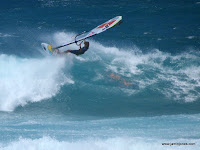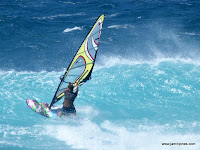 Hey - first off, yes I know it's been a long long time that I last posted. But it's not for anything bad. Actually all is pretty great. We're back on Maui and I got a completely healed and good to go report from my doctor and surgeon over the summer. Also some early season decent waves are coming soon. Maybe more on that later.
Hey - first off, yes I know it's been a long long time that I last posted. But it's not for anything bad. Actually all is pretty great. We're back on Maui and I got a completely healed and good to go report from my doctor and surgeon over the summer. Also some early season decent waves are coming soon. Maybe more on that later.
My inspiration for suddenly writing came from a story a friend of ours just posted about her experience losing her windsurfing gear the other day at Kanaha. So first read her whole story here!
I was going to add a super long comment to Karen's post, but instead of taking up way too much space there, I thought it would be a good idea to post it here instead. So this is that comment, which all about getting back to your gear after a wipe out...
Hey Karen, great story! And nice to see you came out all good and got your gear back more or less intact.
I've had three long swims myself in the past few years, all on big wave days where I got taken out and my gear was washed far away. The first time a kiter towed me back to my wayward kit. (Thank you very much again!) I'm pretty sure I never would have caught up to it on my own. The 2nd and 3rd times happened last year and Julia found and held onto my gear each time and eventually I did catch up. But it took some hard and very exhausting swimming to get there. Also two days ago, again in no waves, Julia and I found a guy swimming with just his rig at Uppers, pretty far out. His board (actually the euro pin base) had separated. We helped him de-rig and took turns sailing the pieces back while Jasek towed him in. Really not a hard process but if we hadn't found him I think he was in for a bad time.
More thoughts on this (and BTW this isn't specific to Karen's story, just general advice)...
1) when possible sail with a friend or partner or at least in close proximity to other folks. Also if you're with someone try to let them know if you decide to head back to shore for some reason (Julia and I use the head pat signal for heading in). If headed to a different location (uppers instead of lowers) we usually get our wing man's attention and point in that direction so they know we're going (and the wing man should follow). It's great knowing that someone is around "just in case".
2) It's a good idea to carry extra line/ rope. This makes it much easier to tow back gear or do on the water MacGyver repairs, etc. I've been toying with the idea of carrying a survival bracelet which allows you to carry 14 ft on your wrist. In theory you can make your own such bracelets - anyone ever tried to do that?
3) Do not hesitate to signal to people or lifeguards if assistance is required. For instance that time I got towed by a kiter - I was waving pretty frantically and the tow took only a few minutes. If I had waited longer it would have just been a longer tow and I would have been that much more tired. The only time I got a tow from a lifeguard (broken uni on a big wave day) he told me that I should sit on my board and wave my hands continuously. They were already out rescuing people in on this day, and by making yourself obvious it takes some pressure off them deciding if you are in fact in trouble (plus it's easy to get the rescue before you get carried back into the impact zone). But don't signal unless you're in a situation where you know you won't be able to get in by yourself (in my broken uni case I was drifting back out on the tide/channel, the wind was dying, it was late in the day, and the waves were BIG!). Also keep in mind that the lifeguards leave around 4pm and plan accordingly.
4) I don't like to sail way far out past the surf zone, particularly way past where most folks tend to hang, and most particularly on a big wave day. If something freaky happens, like you blow a duck jibe way outside and your gear sails on without you down a swell (which has happened to me but I was fortunately able to catch up, though it was amazing and scary how far away it had traveled), it's likely you would not be spotted by anyone and could have a long and painful swim to shore. Plus I try to stay closer to the zone because it's easier to spot and catch the incoming swell.
5) Swimming lessons and/or swimming laps are definitely a good idea. We tend to take it for granted that we can be far from shore when windsurfing. In theory we should be able to swim back from wherever we are just in case. In practice I'm pretty sure most of us would not always be comfortable doing so. If you can swim a mile without getting exhausted you're probably OK. Also when it comes to catching your gear, swimming a quick sprint can make the difference between catching it or waving goodbye. So I would mix sprints with distance. Of course I really never do this (but I really should). Julia was a college competitive swimmer (Notre Dame) and I'm always amazed how much faster she is than me when I (rarely) swim in a pool. Also don't make the mistake that if you surf and paddle - even long paddles like at Lowers - that means you can swim OK. It's very different.
6) And being able to swim fast in particular helps. Consider.. your gear is moving away from you at a certain speed, depending on the current and the wind. Maybe 2 mph. So if you can only swim at 2 mph you will never ever catch your gear, no matter how long you can swim, even if your stuff is only 10 feet away! If you can swim at 2.5 mph and your gear is 1/16 mile (100 yards) away then it's going to take you 7.5 minutes to catch it. If you can swim at 3 mph you reduce this to 3.75 minutes. At 3.5 mph (a fast sprint) you get to it in 150 seconds. So I'm thinking if I can swim fairly fast for 3 minutes or so, I should catch my gear even if it's pretty far away (an entire football field) and moving away at a good clip. Anyway that's the theory, I still need to swim the laps first.
7) I've been surfing with these swimming/surf gloves and they do make you a faster paddler and you can catch more waves (my surf board is only 8 ft BTW). They should also make you a faster swimmer - though I suggest swimming laps first with these in a pool to get used to them. I'm considering stuffing these down my shorty in case a quick swim to my gear (see above) is needed.
8) Even better would be some kind of mini flippers that could be carried on your back or attached to the back of a harness. Something that would be out of the way until needed, really easy to put on, and light. Flippers really increase your swimming power and endurance. I've done some searching and found these that might do the trick. Has anyone tried anything like this before?
9) One last final thought. Last year on both of my long lost gear swims, I was wearing neoprene shorts (impact protection from loops), board shorts (looks cool, pocket for keys), a rash guard (comfort), a harness (required), a Gath surf helmet (concussions are not cool), and at the time an impact vest (still recovering from chest surgery). And it occurs to me that none of that helps you swim faster. Put all that on in a pool and I'm sure you won't be breaking any speed or endurance records. So I decided to ditch much of this in favor of one light weight shorty. That and the harness and helmet, but now I have a smaller, lighter, and generally more comfortable harness, so that should help. The idea is less is more, as in swim more faster. I hope!
 [ For now just the pictures, story later ]
[ For now just the pictures, story later ]






















































































































































